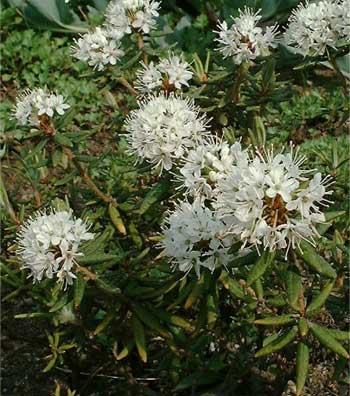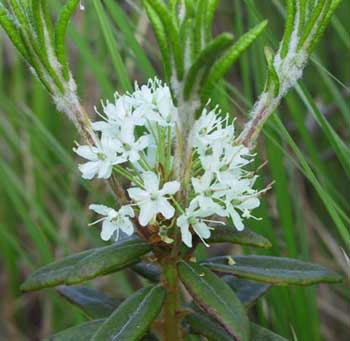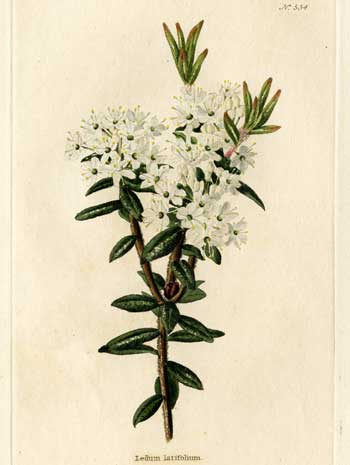Contents:
Common Names | Parts Usually Used | Plant(s) & Culture | Where Found | Medicinal Properties
Uses | Formulas or Dosages | Warning | Bibliography
Scientific Names

- Ledum palustre L.
- Ledum latifolium
- Ledum groenlandicum L.
- Ericaceae
- Heath family
Common Names
Ledum palustre:
- Marsh cistus
- Moth herb
- Narrow-leaved Labrador tea
- Swamp tea
- Wild rosemary
Ledum latifolium:
- James tea
- Labrador tea
- Wild rosemary
- Continental tea
Ledum groenlandicum:
- Labrador tea
Parts Usually Used
Ledum palustre: The entire plant
Ledum latifolium: Leaves
Ledum groenlandicum: Leaves
Back to Top

Description of Plant(s) and Culture
Ledum palustre:
Marsh tea is an evergreen shrub; the rust-colored, woolly branches bear alternate, leathery, linear leaves that are green and glabrous on top and covered with rust-colored down beneath. Terminal umbels of white, or sometimes rose-colored, bell-shaped flowers appear from May to July.
Ledum latifolium:
This species is called both Labrador tea and Marsh tea; it is an evergreen shrub; a low ornamental plant from 1-6 feet high, having narrow, dark leaves lined underneath with rust-colored woolly hairs and bearing white, bell-shaped flowers in early spring. During the American Revolution the leaves are said to have been used as a substitute for commercial tea.
Ledum groenlandicum:
Labrador tea is an evergreen shrub; growing 3 feet high, the leathery leaves are fragrant, oblong or linear-oblong; white or rusty woolly hairs underneath; edges turned under. Small white flowers in terminal clusters from May to July.
Back to Top
Where Found
Ledum palustre:
Grows particularly in peat bogs and moist places in the northern areas of North America, Europe, and Asia. It is sometimes cultivated as an ornamental.
Ledum latifolium:
Common to North America and is found as far south as Wisconsin and Pennsylvania.
Ledum groenlandicum:
Found in peat soils, bogs; from Labrador to New Jersey; Ohio, Michigan, Wisconsin, Minnesota; across Canada to Alaska.
Back to Top

Medicinal Properties
Ledum palustre: Astringent, diaphoretic, diuretic, expectorant
Ledum latifolium: Expectorant, diuretic, pectoral
Ledum groenlandicum: Astringent, diaphoretic, diuretic, expectorant
Back to Top
Uses
Ledum palustre:
Marsh Tea is used externally and makes a good remedy for all kinds of skin problems, boils. Internally, it stimulates the nerves and the stomach, headache. An infusion or cold extract is used for rheumatism, gout, and arthritis. A syrup made from marsh tea is sometimes used for coughs and hoarseness.
Ledum latifolium:
Useful for colds, asthma, bronchial, tuberculosis, and pulmonary problems. Externally, used for eczema, acne, erythema nodosum, gout, rheumatism, stings, tetanus, tinnitus (ringing of the ears), wounds, boils, bruises, deafness, ear inflammations, prickly heat, scabby dandruff.
Ledum groenlandicum:
Native Americans used the leaf tea for asthma, colds, stomachaches, kidney ailments, scurvy, fevers, rheumatism, blood purifier. Externally, used as a wash for burns, ulcers, stings, chafing, poison ivy rash. Folk remedy for coughs, lung ailments, dysentery, indigestion; used externally for leprosy, itching, and to kill lice.
Back to Top
Formulas or Dosages
Ledum palustre:
Infusion: steep 1 tbsp. dried leaves or herb in 1/2 cup boiling water. Take 1/2 cup per day.
Cold extract: Soak 1 tbsp. dried leaves or herb in 1/2 cup cold water for 10 hours. Take 1/2 cup per day.
Ledum latifolium:
Decoction: 1 oz. tea to 2 pints boiling water; drink as required, a mouthful at a time.
Ledum groenlandicum:
Decoction: 1 oz. tea to 2 pints boiling water; drink as required, a mouthful at a time.
Back to Top
Warning
All varieties: Excessive doses can cause poisoning.
Back to Top
Bibliography
![]() Eastern/Central Medicinal Plants
Eastern/Central Medicinal Plants, by Steven Foster and James A. Duke., Houghton Mifflin Company, 215 Park Avenue South, New York, NY 10000
![]() The Herb Book
The Herb Book, by John Lust, Bantam Books, 666 Fifth Avenue, New York, NY. copyright 1974.
![]() Indian Herbalogy of North America
Indian Herbalogy of North America, by Alma R. Hutchens, Shambala Publications, Inc., Horticultural Hall, 300 Massachusetts Avenue, Boston, Massachusetts 02115, 1973
